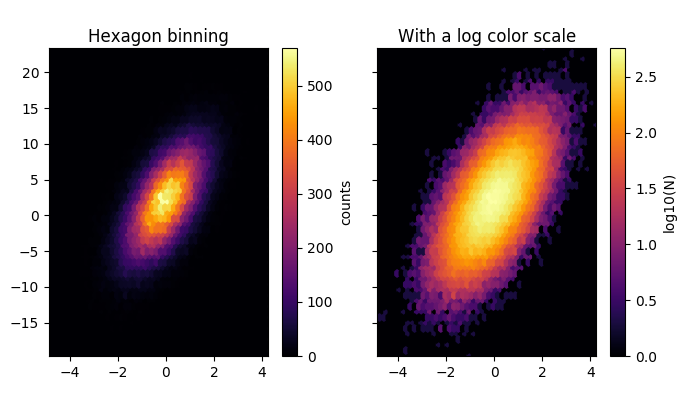
Axes.hexbin(x, y, C=None, gridsize=100, bins=None, xscale='linear', yscale='linear', extent=None, cmap=None, norm=None, vmin=None, vmax=None, alpha=None, linewidths=None, edgecolors='none', reduce_C_function=<function mean>, mincnt=None, marginals=False, **kwargs)¶Make a hexagonal binning plot.
Make a hexagonal binning plot of x versus y, where x, y are 1-D sequences of the same length, N. If C is None (the default), this is a histogram of the number of occurences of the observations at (x[i],y[i]).
If C is specified, it specifies values at the coordinate (x[i],y[i]). These values are accumulated for each hexagonal bin and then reduced according to reduce_C_function, which defaults to numpy’s mean function (np.mean). (If C is specified, it must also be a 1-D sequence of the same length as x and y.)
| Parameters: | x, y : array or masked array C : array or masked array, optional, default is None gridsize : int or (int, int), optional, default is 100
bins : {‘log’} or int or sequence, optional, default is None
xscale : {‘linear’, ‘log’}, optional, default is ‘linear’
yscale : {‘linear’, ‘log’}, optional, default is ‘linear’
mincnt : int > 0, optional, default is None
marginals : bool, optional, default is False
extent : scalar, optional, default is None
|
|---|---|
| Returns: | object
|
| Other Parameters: | |
cmap : object, optional, default is None
norm : object, optional, default is None
vmin, vmax : scalar, optional, default is None
alpha : scalar between 0 and 1, optional, default is None
linewidths : scalar, optional, default is None
edgecolors : {‘none’} or mpl color, optional, default is ‘none’
|
|
Notes
In addition to the above described arguments, this function can take a data keyword argument. If such a data argument is given, the following arguments are replaced by data[<arg>]:
Examples
(Source code, png, pdf)
